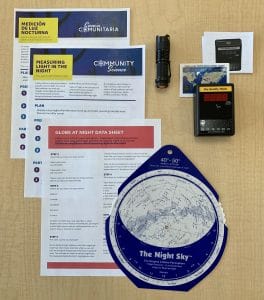Measuring Light in the Night
Why Do Scientists Study Light Pollution?
Scientists study light pollution in order to better understand how it impacts the climate and the ecosystem in urban areas. The thousands of lights that illuminate the cities of today have been shown to increase the average air temperature which contributes to the harmful effects of climate change.
Check out the kit
Check out the kit for free with your library card. You can see if the kit is available in the catalog, and if it's checked out, place a hold to get on the waiting list.
Kits check out for 3 weeks.


About this Kit

In this kit
Sky quality meter (SQM)
Red LED light flashlight
Planisphere (constellation guide)
Activity guide (Spanish and English)
Night sky data sheet pad (Spanish and English)
Survey (Spanish and English)
How to help scientists collect data using your smartphone or tablet
Step 1
Turn on the GPS feature. You can also use Google Maps or download a free GPS-Map app for your iOS Apple or Android device.
Step 2
On a night when the moon is not high, at least an hour after sunset, go outside to a clear spot with your Sky Quality Meter (SQM), your planisphere/constellation guide, and your red LED flashlight to protect your night vision. Make sure to write down the serial number of your SQM for when you are submitting your data.
Step 3
With the sensor/faceplate pointing towards the sky, push the red button on your SQM once and wait as it takes its reading. Once it’s finished be sure to take note of the measurement or record the measurement on the data card.
Step 4
Using your planisphere and the Observe tab on the Globe at Night website to locate the constellations suggested in the Globe at Night Dates and Constellations section based on the date of your observation.
Step 5
Go to the Globe at Night website to enter the data you collected from your observation. Allow the webapp to use your current location.
Step 6
Check the picture on the top of the kit and make sure all the items are there before you return it to the library.
Please fill out the survey you'll find inside the kit to let us know if you liked it.
Thank you for your participation!
Don't have a smartphone or tablet?
You can use a library computer to participate in this project.
Step 1
On a night when the moon is not high, at least an hour after sunset, go outside to a clear spot with your Sky Quality Meter (SQM), your planisphere/constellation guide, and your red LED flashlight to protect your night vision. Make sure to write down the serial number of your SQM for when you are submitting your data.
Step 2
With the sensor/faceplate pointing towards the sky, push the red button on your SQM once and wait as it takes its reading. Once it’s finished be sure to take note of the measurement or record the measurement on the data card.
Step 3
Using your planisphere locate the constellations suggested based on the date of your observation.
Step 4
Go to the Globe at Night website to enter the data you collected from your observation.
Step 5
Check the picture on the top of the kit and make sure all the items are there before you return it to the library.
Please fill out the survey you'll find inside the kit to let us know if you liked it.
Thank you for your participation!
